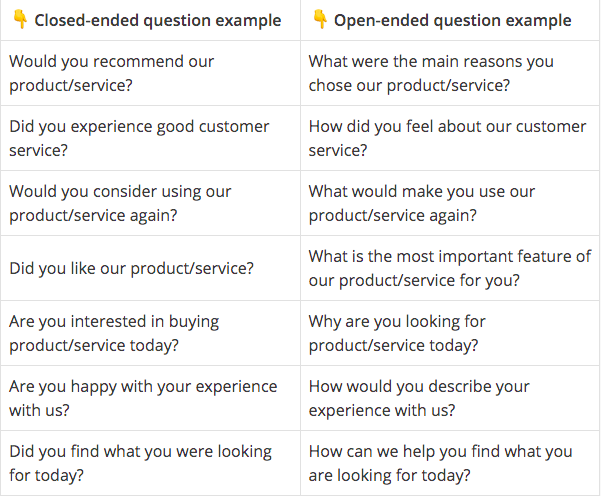In this article, we’ll go over best habits to get into for asking open-ended questions, when to use closed-ended questions instead, scenarios when you might need to use both, the differing ways they impact data collection, and some examples of open versus closed questions as used in marketing, sales and content interviews.
- “How many years did you work for your last employer?”
- “Have you ever worked in a different industry?”
- “What’s the longest you’ve worked for any employer?”
- “Are you comfortable working remotely or in a hybrid environment?”
- “Do you prefer working with a team or independently?”
Closed Question Interview
In shopper behavior analysis:
- Open-ended questions spend time peeling back the layers of why someone feels some way about a product.
- Closed-ended questions take a person through their buying habits: how often do they buy a product, which brand do they typically buy, have they heard of your brand, do they buy it.
Don’ts for crafting closed-ended questions:
- Don’t provide a selection of multiple choice answers that’s too limited to cover the full range of possibilities.
- Don’t assume that everyone will be able to make a yes/no answer based on their experience of something.
- Don’t attempt to craft complex or two-part questions as you might with an open-ended question.
- Don’t use this format to explore emotions or feelings.
- Don’t create a survey or study that is only closed-ended questions; at minimum have an open-ended question at the end of each section that allows people to explain their answers or give context to them.
Let’s have a look at the different purposes they serve, how they complement each other, what kind of data they garner, and how each can be used in our three scenarios (a sales call, a marketing exercise, a writers’ interview).
- An open-ended question opens up a topic for exploration and discussion while a closed-ended question leads to a closed-off conversational path. After “Yes” or “No” or the specific one-word answer to the question, the thread is done.
- Open-ended questions lead to qualitative answers while closed-ended questions lead to quantitative answers.
- Open-ended questions ask people for their why while closed-ended questions ask people for their decision.
How many years of experience do you have?
Its common for hiring managers to ask you how many years of experience you have in the field. Your answer can help them determine if youre more entry level or if you have enough experience to fulfill the requirements for a more advanced position. An interviewer also asks so they can feel confident in your abilities if they decide to hire you for the position.
Example: “I have five years of relevant experience. Within those five years, Ive assumed many roles that have given me a more comprehensive view of how operations work in this industry. I look forward to learning even more in a new role.”
Thus, as the interviewer, you must think carefully about the question types you will use. Both open-ended and closed questions have advantages and drawbacks, as shown in the figure below. Notice that choosing one question type over the other actually involves a trade-off; although an open-ended question affords breadth and depth of reply, responses to open-ended questions are difficult to analyze. Attributes of open-ended and closed questions.
A closed question limits the response available to the interviewee. You may be familiar with closed questions through multiple-choice exams in college. You are given a question and five responses, but you are not allowed to write down your own response and still be counted as having correctly answered the question.
Open-ended questions include those such as “What do you think about putting all the managers on an intranet?” “Please explain how you make a scheduling decision.” “In what ways does the system extend your capability to do tasks that would not be possible otherwise?” Consider the term open-ended. “Open” actually describes the interviewee’s options for responding. They are open. The response can be two words or two paragraphs. Some examples of open-ended questions are shown below.
The alternative to open-ended questions is found in the other basic question type: closed questions. Such questions are of the basic form “Is it easy to use the current system?” and, “How many subordinates do you have?” The possible responses are closed to the interviewee, because he or she can only reply with a finite number such as “None,” “One,” or “Fifteen.” Some examples of closed questions are listed below.
A third type of question is the probe or follow-up. The strongest probe is the simplest: the question, “Why?” Other probes are “Can you give me an example of a time you did not find the system trustworthy?” and “Will you elaborate on that for me?” Some examples of probing questions are listed below. The purpose of the probe is to go beyond the initial answer to get more meaning, to clarify, and to draw out and expand on the interviewee’s point. Probes may be either open-ended or closed questions.

